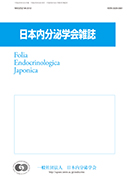巻号一覧

29 巻 (1953 - 1954)
- 11-12 号 p. 235-
- 9-10 号 p. 217-
- 7-8 号 p. 155-
- 5-6 号 p. 125-
- 3-4 号 p. 91-
- 1-2 号 p. 1-
前身誌
29 巻, 11-12 号
選択された号の論文の4件中1~4を表示しています
- |<
- <
- 1
- >
- >|
-
植野 芳樹1954 年 29 巻 11-12 号 p. 235-273,305
発行日: 1954/03/20
公開日: 2012/09/24
ジャーナル フリーThere are four methods of producing experimental diabetes mellitus in animals. 1) most classic method by pancreatectomy (Mehring, Minkowski) 2) method by repeated injection of pituitary anterior extract (Young, Houssay) 3) method by alloxan injection (Dunn) 4) method by repeated glucose injection of large quantities Dohan ohan, Lukens). Of these, a method which is simplest in technique and lowest in cost is by alloxan, a simple chemical substance, injection, and therefore the pathophysiological studies in alloxan diabetes are conviniently achieved, and in many countries in Europe and America had been often reported but rarely in Japan.
I tried a few tests about pathophysiological changes of rabbits alloxan diabetes mellitus. In every rabbit alloxan injected 200mg/kg intravenouslly after 24 or 36 hours starvation. Results were summarized as follows.抄録全体を表示PDF形式でダウンロード (5185K) -
井上 功, 片山 皎一, 鳥居 忠彦, 藤田 忠正1954 年 29 巻 11-12 号 p. 274-281,307
発行日: 1954/03/20
公開日: 2012/09/24
ジャーナル フリーWe determined acetone-bodies in urine of 29 diabetics before and after insulin therapy, and results are as follows:
1) Acetone-bodies excretion in a day is found to be increased in all cases.
2) Ketosis is not closely related to the severity of symptoms, and there seems to be certain cases which ketosis is only serious in spite of slight symptoms. We think that such kind of diabetes may be called ketosis type.
3) In true diabetes and pluriglandular diabetes, ketosis ranges from low grade to high glade, on the other 'hand in extrapancreatic diabetes, ketosis is low grade in general.
4) In most cases excluding ketosis type, ketosis is decreased by insulin therapy.
5) Ketosis in diabetic coma in Japan is not so severe as that in Europe. From this fact, we may think that ketosis is not the only cause of diabetic coma.抄録全体を表示PDF形式でダウンロード (951K) -
安藤 卓爾, 阿部 徳良, 土居 智財, 大樋 知邦, 東森 四郎1954 年 29 巻 11-12 号 p. 282-287,307
発行日: 1954/03/20
公開日: 2012/09/24
ジャーナル フリーExtirpation of the adrenal or the pituitary has been shown to prevent the roduction of pancreatic diabetes. These facts show the important role of the adreno-Cortical hormone in diabetes. Adreno-cortical hormone could be divided into glucocorticoid and mineralocorticoid. The former has diabetogenic action but the latter has not. It is generally accepted that glucocorticoid is produced from the inner part of the cortex, and mineralocortcoid from the outer part of it.
We have confirmed in rats experiment that hypertrophy of the zona glomerulosa and atrophy of the zona fasciculata have been caused by feeding with potassium chloride for long period.
In these animals, we examined the course of alloxan diabetes.
The results are as follows:
1) Administration of potsssium Chloride produces hypertrophy of the zona glomeruloa and atrophy of the zona fasciculata in rabbits.
2) Alloxan was then injected in rabbits feeded with potassium, in dose which could destroy almost all the beta cells of the islets. The grade of hyperglycemia was slight. But the phase of hypoglycemia appeared relatively early, and severe hypoglycemia was observed. During few days, hyperglycemia continued temporarily and did not occur the persistes in the experimental rabbits.
3) Potsssium chloride could not protect in any way the beta cells of the islets from the injuring effect of alloxan.
4) These suppretion of the blood sugar following the administration of potassium chloride is interpreted as being to the atrophy of the zona fasciculata of the adrenal cortex.抄録全体を表示PDF形式でダウンロード (3116K) -
田中 育郎1954 年 29 巻 11-12 号 p. 288-304,308
発行日: 1954/03/20
公開日: 2012/09/24
ジャーナル フリーIn order to determine the relation of the adrenals to alloxan initial hyperglycemia in non-anesthetized dogs, the presnt investigation was performed.
1) All experiments were undertaken in non-anesthetized, non-fastend dogs. Alloxan was given intravenously in a dose of 100mg per kg of body weight..
2) In normal control dogs, the initial hyperglycemia preceded by the slight hypoglycemia, appeared within about an hour after the injection. It arrived at the peak within four hours or so, and proceeded to the following hypoglycemia within about seven hours..
3) When alloxan was injected in non-anesthetized demedullated dogs, the initial hyperglycemia was observed in a magnitude not less than that in the normal control dogs..
4) In two dogs with dorsal spinal roots sectioned previously, the bilateral adrenal glands were removed without anesthesia and alloxan was injected. In one dog a mild hyperglycemia in the initial period was observed, but in the other the same initial hyperglycemia as that in the normal control dogs was found..
5) In the dogs with sectioned dorsal spinal roots, the adrenal venous blood was collected before and after the alloxan injection without narcotizing, fasting, laparotomy or evoking pain. The adrenaline content in the specimens was measured by the rabbit intestine segment method. It was found that the adrenaline secretion rate remained unchanged during the initial hyperglycemic phase. But the augmented adrenaline secretion was observed during the following hypoglycemic phase..
These experimental results signify the fact that the alloxan initial hyperglycemia is not due to the augmented arenaline secretion from the adrenal medulla. Hence, it is concluded that the alloxan initial hyperglycemia is not connected with adrenal medulla.抄録全体を表示PDF形式でダウンロード (2807K)
- |<
- <
- 1
- >
- >|